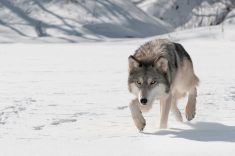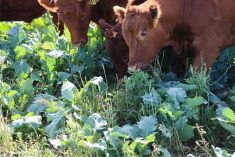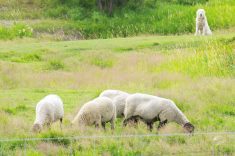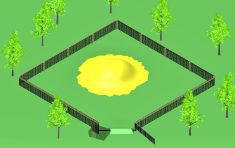When some ranchers get on in years, they get to be like a ball of rusty old barbed wire.
Before even thinking about straightening them out – or talking about newfangled ideas in the cattle business – proceed with caution.
But for Ron Batho, 74, who has been ranching near Oak Lake since 1952, trying out a new grazing strategy on his 2,827- acre spread wasn’t a cause for stress.
“Life is a learning experience,” said Batho, a longtime Hereford breeder and operator of the Southwest Bull Development Centre.
Read Also

Pig transport stress costs pork sector
Popular livestock trailer designs also increase pig stress during transportation, hitting at meat quality, animal welfare and farm profit, Agriculture and Agri-Food Canada researcher says
“If you bury your head in the sand, first thing you know you’ll get left behind and you’ll never, ever catch up. You’ve got to be open minded.”
For Batho, getting started in twice-over grazing, which proponents say improves grass productivity through regular pasture rest periods over the summer, was made easier through a five-year deal under the Mixed Grass Prairie Project administered by Manitoba Conservation.
Operating as a kind of temporary conservation easement, with a 75 per cent cost-sharing incentive of up to $2,500 per half section for installing equipment such as electric fences, watering lines and pumps, the program is pitched as a win-win for wildlife as well as ranchers, according to Kathy Murray, a biologist with Conservation’s Critical Wildlife Habitat program.
The goal is to help ranchers see the benefits in preserving the province’s dwindling areas of uncultivated grassland, even going so far as weighing cattle in the spring and fall to determine rates of gain, she said.
“The idea is that the ranchers get financial benefits from their land without having to plow it,” said Murray.
Some 30-40 ranchers are currently involved in the project, and funding to cover roughly 10 half sections of native prairie is available for new entrants each year.
On a tour organized by the Southwest Grazing Club, Batho showed the effects of five years of twice-over grazing on four native grass paddocks that had never been put to the plow.
He noted that he hadn’t been thrilled with the results from years of continuous grazing because less desirable species such as goldenrod and woody species had been taking over, so he was keen to try something new.
MIDDLE GROUND
Because of his sandy soil, Batho is not sold on the virtues of Allan Savoury-style, high-intensity, short-duration grazing, also known as “mob” grazing. Designed to mimic the soil-building effect of large herds of wildlife such as the bison of yore, it aims to boost pasture productivity, water infiltration and nutrient cycling via long pasture rest periods and the stimulating action of trampling hooves.
Instead, he’s more inclined toward the work of North Dakota State University rangeland scientist Llewellyn “Lee” Manske, who advocates twice-over grazing as a kind of middle ground between the two extremes of mob and continuous grazing.
The results have been positive, he added, with better thatch and leftover grass cover on top of the sandy ground helping to retain moisture and prevent the soil from getting scorched during dry spells. That’s important in the southwest corner of the province, where ranchers are literally “never more than a week away from a drought” without regular rains.
“If we get some 35 temperatures, in a week, boy, we’d be thinking a little rain would be nice,” said Batho.
Under the system, the cattle first hit the grass on June 1 and then must be taken out by Oct. 15. They graze each paddock twice each summer – hence the name. The first pass, of 15 days’ duration, is aimed at stimulating growth by snipping off the grass at the three-leaf stage before it starts to divert energy toward seed formation. The second “harvest” grazing period lasts 30 days, and then the cattle are rotated out before the grass gets beaten down too much in fall.
The management rules aren’t overly onerous, said Batho, but the grazing deadlines must be followed even if the grass seems lush enough to squeeze a few extra weeks out of it.
“You lock everything up and then you’re not even supposed to look over the fence,” he joked.
A side experiment is also underway of mowing brush species such as wolf willows, snow-berry and buck brush as a non-chemical means to weaken their root reserves and encourage the grass to come up in its place.
Batho has seen a lot of different trends in the cattle industry come and go over his lifetime, but he’s determined to keep trying new things.
“I’m going to stay at this until the day my grandsons put me on the calf sled and take me up in the hills for the crows and coyotes,” said Batho.
For more information on twice-over grazing, see Lee Manske’s website at www.grazinghandbook.com. [email protected]
———
“Ifyouburyyour headinthesand, firstthingyouknow you’llgetleftbehind andyou’llnever,ever catchup.You’vegot tobeopenminded.”
– RON BATHO


















